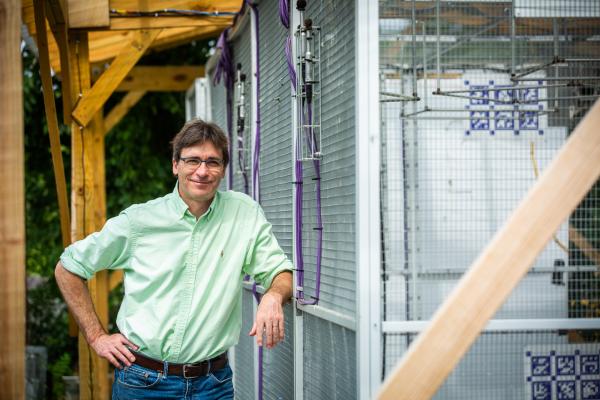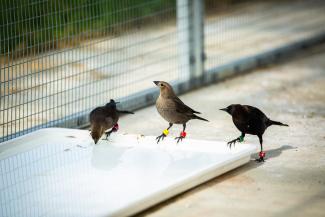In the highly social world of brown-headed cowbirds, a migratory species native to the Great Plains of North America, every song, sound, and pose has a meaning—especially during mating season. When it’s time to entice a potential partner, male cowbirds whistle proudly as they fluff their feathers, spread their wings, and bow. If the female cowbird is interested, she’ll strike a pose that shows the male she’s receptive to his advances. These behaviors stem from a part of the cowbird’s brain called the song circuit.
While the rapid-fire melody of a cowbird may not seem remarkable to those unfamiliar with its song, it actually represents a complex and metabolically costly social behavior formed by millions of years of evolution. Behaviors like these provide researchers an opportunity to explore the neural circuits that drive communication in social animals.
This summer, Penn undergraduates Julia Youngman and Eric Tao studied the brains and behavior of cowbirds as part of the Penn Undergraduate Research Mentoring Program (PURM), administered by the Center for Undergraduate Research and Fellowships. PURM students receive a $5,000 award to work with professors for a 10-week summer research project.
Youngman is a third-year student from Mountain Lakes, New Jersey, studying biology with a concentration in ecology and evolution. Tao is a second-year student from Wallingford, Pennsylvania, planning to major in mathematics and cognitive science. Both were drawn to the interdisciplinary nature of behavioral neuroscience research and excited to work hands-on with animals.
The two have pursued their summer investigations under the guidance of Marc Schmidt, a biology professor in the School of Arts & Sciences. In 2015 Schmidt began building a “smart” aviary, an enclosure that records every movement and melody of the gregarious birds that live inside it. Using the aviary alongside laboratory experiments, Schmidt endeavored to understand avian mating rituals from a neuroscientific perspective.

Youngman says Schmidt’s lab was her first choice because it would allow her to integrate the individual skills she’d learned in her coursework at Penn. “My behavior classes focused solely on behavior and fieldwork,” she says. “And my microbiology classes focused on the mechanics. And I felt like this lab married those two ideas.”
From everyday tasks like data annotation and bird feeding to complex techniques like coding and surgery, undergraduates in Schmidt’s lab have the chance to directly participate in cutting-edge research about the neuroscience of songbird mating behaviors. In addition to Tao and Youngman, seven other undergraduate researchers are working in his lab this summer through programs like the MindCORE Summer Fellowship Program. Schmidt emphasizes the importance of including undergraduates in the research process and is grateful for the fresh perspectives and diverse backgrounds they bring to his lab. “Without undergrads, I would not be able to do what I do,” he says.
Smart aviary science
Schmidt studies a neural circuit in male and female brown-headed cowbirds called the song pathway. In males, the song pathway runs from the brain to the muscles that the bird uses to produce its mating calls. The brains of female cowbirds also contain an analogous song circuit, but female cowbirds don’t sing; so, Schmidt wanted to ascertain the biological purpose of the female song pathway.
The smart aviary, located at Pennovation Works, has enabled the lab to approach this question in new ways. The enclosure contains 15 birds, 10 cameras, and 24 microphones. The cameras and microphones track each and every bird’s movements, songs, and social interactions, around the clock.
RELATED
- ‘Smart aviary’ poised to break new ground in behavioral research
- Singing, speech production, and the brain
- What the genomes of ancient humans can teach us about modern health
The end goal of the smart aviary is to set up an “automated pipeline” of behavioral data, says Schmidt. Currently, the researchers in the lab must manually annotate all of the footage and recordings from the smart aviary by hand-marking the location and pose of each bird. Once they’ve annotated enough of the footage, they’ll be able to build a program that tracks the birds automatically using machine learning. Annotating just 15 minutes of footage can take up to 40 hours, says Schmidt.
Building a program to track the birds automatically will require knowledge not just of avian behavior, but also mathematics and computer science. This summer, Tao used his mathematics background to help build an audio component for the automated pipeline. The program he’s working on will use data from all 24 microphones to localize and identify different types of songs from the cowbirds.

“A lot of the interesting behaviors that the birds display is through song and through chatter,” explains Tao. The program he’s building will allow the lab to feed in an audio segment and immediately know where, when, and how different birds in the aviary are singing.
Tao’s mathematics background has also come in handy when it comes to studying relationships between birds. Using a technique called graph theory, he can represent the social structure of the flock numerically. “Each individual bird is a node of a graph,” he says. “And the lines connecting the birds show the strength of the connection between the two birds.” The ultimate result is a network of connecting points that can be analyzed to reveal patterns in the birds’ relationships.
Youngman, on the other hand, is employing her biology skills to work directly with the flock. After learning about the neuroanatomy of the birds, she’s had the opportunity to assist in surgeries, dissections, and electrophysiological recordings.
Youngman’s research aims to elucidate the purpose of the female cowbird song pathway. By stimulating nerve cells and injecting molecular tracers that expose the trajectory of neurons, Youngman and Schmidt have found that while the female cowbird doesn’t use the song pathway to sing like male cowbirds do, it still plays a key role in reproductive behaviors.

This summer, Schmidt found that muscles around the female cowbird’s quadricep and cloaca—areas both involved in the copulatory response, a behavior of female songbirds that indicates they are receptive to mating—were both innervated by the song system. These results suggest a neural link between mating songs in males and mating responses in females.
Interdisciplinary innovators
By combining the behavioral techniques of the smart aviary and the traditional biological techniques of the lab, Schmidt and his undergraduate researchers are helping pioneer how the neural bases of complex social behaviors are studied. “We are going to push the limits of some of the technical mathematical tools that are used to study groups of animals,” says Schmidt.
This sort of research requires bringing together different scientific disciplines, which isn’t always easy. “It can be very challenging to be multidisciplinary and integrative,” admits Schmidt. So, this summer he worked to foster that kind of open mindset in his lab members by encouraging students to read scientific literature from each other’s disciplines. Schmidt also built camaraderie with lab field trips to places like the Philadelphia Museum of Art, where every student found and shared a piece of art they thought connected to their research.
Both Tao and Youngman say they enjoyed the community they found in their lab. “It’s really cool because we have people of all different backgrounds,” Tao says.
Schmidt agrees that those different backgrounds are what makes the lab experience special. “It starts out with you teaching them. But then it becomes this organic feel, where everybody’s teaching everybody, and everybody’s learning from everyone.”

